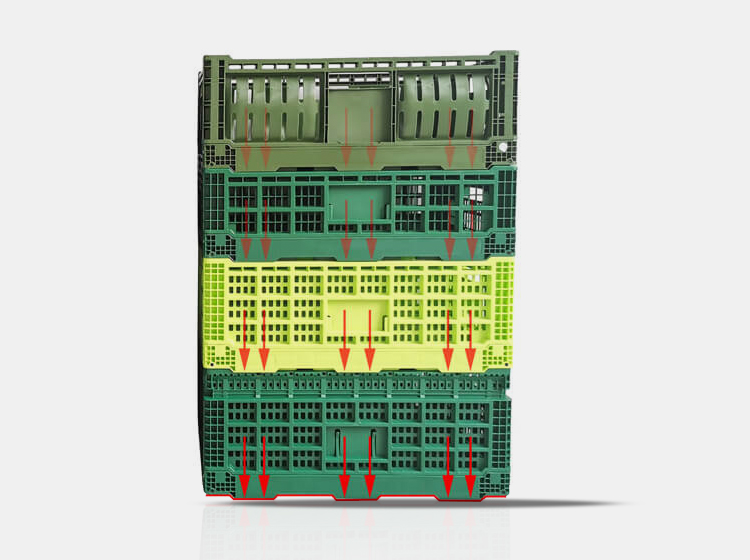Plastic fruit crates are designed to minimize the risk of contamination and preserve the quality of fresh produce through several key features and properties. These crates are increasingly used in the agricultural and food distribution industries due to their durability, hygiene, and efficiency. Here’s how plastic fruit crates help maintain the quality of fruits and vegetables while reducing contamination risks:
Hygienic Properties
Non-Porous Material: Unlike wooden crates, which can absorb moisture and harbor bacteria, plastic fruit crates are made from non-porous materials like polypropylene or polyethylene. This characteristic makes them less likely to absorb liquids, reducing the risk of bacterial growth and contamination.
Easy to Clean: Plastic crates can be easily washed and sanitized. They can withstand high-pressure washing and are often designed to be compatible with various cleaning agents. This ease of maintenance ensures that crates remain clean and free of contaminants between uses.
Reduced Cross-Contamination
Dedicated Use: Plastic crates can be designated for specific types of produce (e.g., apples, berries) or particular stages of the supply chain (e.g., harvesting, transport). This minimizes the risk of cross-contamination between different products, which can occur with crates that are reused for various items.
Color-Coding and Labeling: Many suppliers use color-coded plastic crates for different fruits or vegetables, making it easy to identify which crates have been used for specific types of produce. This organizational system helps maintain food safety standards.
Ventilation and Airflow
Designed for Breathability: Many plastic fruit crates feature ventilation holes and slatted designs that allow for air circulation. Proper airflow helps reduce moisture buildup, which can lead to mold growth and spoilage.
Temperature Regulation: Enhanced ventilation helps maintain the optimal temperature for stored fruits and vegetables, further preserving their quality during transport and storage. This regulation reduces the likelihood of condensation, which can create a breeding ground for bacteria.
Stackability and Stability
Efficient Stacking: Plastic crates are designed to stack securely without compromising stability. This stacking capability allows for efficient use of space during transport and storage, minimizing the risk of crushing or damaging the produce.
Less Physical Damage: When crates are stacked properly, there is less chance of fruit being bruised or damaged. Reducing physical damage helps maintain the quality and marketability of the produce.
Temperature Control
Insulation Properties: Some plastic crates are designed with insulation features that help maintain cooler temperatures during transport, especially in warm climates. Keeping produce at optimal temperatures helps extend shelf life and prevent spoilage.
Compatibility with Refrigerated Transport: Plastic fruit crates can easily fit into refrigerated transport systems, ensuring that produce remains at the right temperature throughout the supply chain.

Tamper-Proof and Secure
Tamper-Resistant Design: Many plastic crates come with secure lids or closures that can protect the contents from external contaminants, pests, or tampering during transport.
Transparent or Semi-Transparent Options: Some crates are designed to be transparent or semi-transparent, allowing for quick visual inspection of the contents without needing to open them. This feature enables suppliers and retailers to check the quality of the produce quickly.
Chemical Resistance
Resistance to Chemicals: Plastic fruit crates are resistant to many chemicals, including those used for cleaning and sanitizing. This resistance ensures that any cleaning agents used do not degrade the material, maintaining the crate's integrity and hygiene.
Safe for Food Contact: Most plastic crates are made from food-grade materials that do not leach harmful chemicals into the produce. This safety is crucial in preventing contamination.
Reduced Spoilage Rates
Longer Shelf Life: By minimizing contamination risks, maintaining proper airflow, and protecting against physical damage, plastic fruit crates contribute to longer shelf lives for fresh produce. This not only preserves quality but also reduces food waste along the supply chain.
Plastic fruit crates effectively minimize the risk of contamination and preserve the quality of fresh produce through their hygienic properties, design features that enhance ventilation and stability, and ease of cleaning. Their ability to reduce cross-contamination and support optimal storage conditions makes them a preferred choice for growers, distributors, and retailers looking to maintain the integrity of their products from harvest to sale. By using plastic crates, the agricultural industry can ensure that fruits and vegetables reach consumers in the best possible condition, contributing to food safety and quality.












ZHEJIANG ZHENGJI PLASTIC INDUSTRY CO. ,LTD born in 1990’s is a professional manufacturer of plastic collapsible boxes, folding crates, storage bins, moving dolly and other plastic products items, etc.
 +0086-573-80886008
+0086-573-80886008Copyright © Zhejiang Zhengji Plastic Industry Co.,Ltd.All Rights Reserved.
